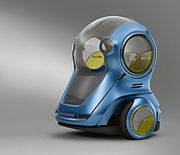General Motors EN-V
| GM EN-V | |
|---|---|
 2012 GM EN-V | |
| Overview | |
| Manufacturer | GM |
| Production | 2011-2014 |
| Body and chassis | |
| Body style | hatchback |
General Motors EN-V (Electric Networked-Vehicle) is a 2-seat urban electric concept car jointly developed by Segway Inc. and General Motors that can be driven normally or operated autonomously.[1][2]
Designed for urban environments and around an extrapolation of the P.U.M.A. prototype announced by GM and Segway in 2009,[3] the EN-V was unveiled at the joint GM & SAIC pavilion at the Expo 2010 in Shanghai from 1 May through 31 October 2010.[3] Three different vehicles are showcased, 笑 Xiao (Laugh), 骄 Jiao (Pride) and 妙 Miao (Magic).[4]
In October 2011 General Motors announced its decision to develop a second concept EN-V under the Chevrolet badge for use in field testing and demonstration programs, beginning in Tianjin, China.[5] In June 2014 General Motors announced it would commence testing of the four wheel EN-V 2.0 at the Tianjin Eco-city[6]
Driverless vehicle[edit]
The most significant feature of the vehicles is autonomous operation.[1][2] The EN-V can detect and avoid obstacles – including other vehicles – park themselves and come to you when called by phone.[1]
Accomplished through a combination of GPS, vehicle-based sensors, and vehicle-to-vehicle communication, this autonomous technology is an extrapolation of that found in GM's 2007 autonomous "The Boss" Chevrolet Tahoe created for the DARPA Grand Challenge (2007).[3][4]
The EN-Vs can communicate with each other allowing platooning, with one or more EN-Vs tagging along automatically behind a leader. Also, if an EN-V detects another in close proximity, it can check what that other is intending to do and agree on how to pass it safely.[1]
Shanghai concept[edit]
Specifications[edit]
Powered by two electric motors, one on each wheel, and a lithium-ion phosphate battery, the EN-V has a top speed of 40 kilometres per hour (25 mph) and a maximum all-electric range of 40 kilometres (25 mi).[1] The sensors and communications equipment which allow it to drive itself include short-range radio and GPS, as well as optical sensors, ultrasonic sensors and doppler radars.[7] The two-wheeled balancing system the EN-V uses was developed by Segway,[1][2] and it may be an extrapolation of that found in the P.U.M.A. prototype announced by GM and Segway in 2009.[3]
The themes[edit]
The three vehicles shown use the same automobile platform but have unique exterior and interior designs.
Xiao (笑)[edit]
Xiao, or laugh, was designed in Australia by the GM Holden Design Studio.[3] Its design is intended to appear friendly.[8]
Xiao Dimensions: 1,540 mm (L) × 1,420 mm (W) × 1,770 mm (H) (60.5 in × 56 in × 69.5 in)[7]
Miao (妙)[edit]
Miao, or magic, was designed at the General Motors Advanced Design Studio in California.[3] Miao's design is mysterious and high-tech.[8] It was also exhibited at the Walt Disney World ride Test Track as a Chevrolet
Miao Dimensions: 1,520 mm (L) × 1,405 mm (W) × 1,635 mm (H) (60 in × 55 in × 64.5 in)[7]
Jiao (骄)[edit]
Jiao, or pride, was designed in Europe by Opel and takes design cues from bullet trains and Chinese opera masks.[3] Its design is supposed to be chic and stylish.[8]
Jiao Dimensions: 1,500 mm (L) × 1,425 mm (W) × 1,640 mm (H) (59 in × 56 in × 64.5 in)[7]
Chevrolet EN-V 2.0[edit]
In October 2011 General Motors announced its decision to develop a second concept EN-V under the Chevrolet badge for use in field testing and demonstration programs in several cities around the world, beginning in Tianjin, China. The Chevrolet EN-V 2.0, as the vehicle is now called, will add new features such as climate control, personal storage space and all-weather and road condition operation while several key elements of the original EN-V will be preserved, such as the small footprint, maneuverability, its battery electric propulsion, connectivity, and autonomous driving capabilities.[5] The new vehicle design as revealed in 2014 has four wheels and has two doors (one of each side).[9] Testing at the Tianjin Eco-city was due to commence in July 2014.
In popular culture[edit]
- The Chevy EN-V is featured in the Walt Disney Pictures film Tomorrowland.[10]
- The EN-V is featured as part of the queue for the Epcot pavilion Test Track at Walt Disney World, which is sponsored by Chevrolet.[citation needed]
See also[edit]
- City Car (Concept)
- Driverless car
- Google driverless car
- MIT Car
- Nissan Pivo
- Personal Urban Mobility and Accessibility
- Renault Twizy Z.E.
- VisLab, and their VIAC intercontinental challenge (driving from Italy to China with autonomous vehicles)
References[edit]
- ^ a b c d e f "The bubble car is back – Cheap, small and simple: an idea from the 1950s bubbles up again". The Economist. 2010-09-30. Retrieved 2010-10-05.
- ^ a b c Jim Motavalli (2010-03-24). "G.M. EN-V: Sharpening the Focus of Future Urban Mobility". New York Times. Retrieved 2010-10-05.
- ^ a b c d e f g GM Unveils EN-V Concept: A Vision for Future Urban Mobility Archived 2011-11-14 at the Wayback Machine gm.com, 2010-03-25
- ^ a b GM Shows Capability of EN-V Concept Vehicles at Expo 2010 gm.com, 2010-08-17
- ^ a b "Chevrolet to produce Spark battery electric vehicle for US and global markets starting in 2013 with A123 Systems pack; EN-V gets a Chevrolet badge". Green Car Congress. 2011-10-12. Retrieved 2011-10-12.
- ^ "GM to Demonstrate Chevrolet EN-V 2.0 in Tianjin Eco-City". 19 June 2014.
- ^ a b c d Specification Sheet[permanent dead link]
- ^ a b c Personality Sketches Archived 2010-03-28 at the Wayback Machine gm.com, 2010-03-23
- ^ "GM demos self-driving micro car in Detroit: Chevy EN-V 2.0". September 9, 2014.
- ^ Tomorrowland Set Images
- Mitchell, William J.; Borroni-Bird, Christopher; Burns, Lawrence D. (2010). "4". Reinventing the Automobile: Personal Urban Mobility for the 21st Century (1st. ed.). The MIT Press. ISBN 978-0-262-01382-6. Archived from the original on 2010-06-09. Retrieved 2010-07-24. See Chapter 4.


